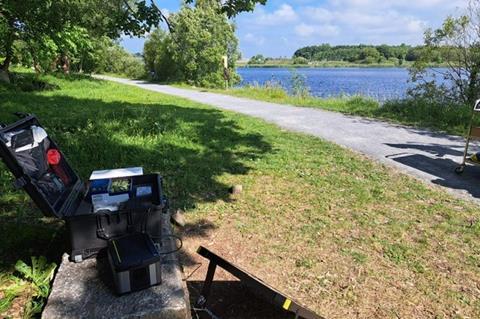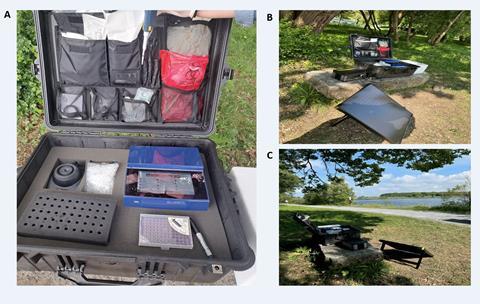Contaminated water is particularly dangerous in rural areas where private groundwater wells supply drinking water to households - but AMI One Health Advisory Group member Dr Zina Alfahl reveals a low-cost, simple way to check for STEC.

In many parts of the world, access to clean drinking water remains a persistent challenge. Waterborne pathogens pose a significant public health risk and among them is Shiga toxin-producing Escherichia coli (STEC) which is considered one of the most dangerous pathogens.
STEC contamination can lead to severe gastrointestinal illness, hemolytic uremic syndrome (HUS) and even death. Despite advances in water monitoring, traditional methods for detecting these pathogens are often slow and require sophisticated laboratory infrastructure. However, we at the University of Galway have developed an innovative, portable diagnostic workstation that could transform how waterborne pathogens are detected in the field.
Hidden threat
STEC is commonly found in the intestines of healthy ruminants, including cattle and can enter water supplies through agricultural runoff, improper waste disposal and other contamination pathways. Contaminated water is particularly dangerous in rural areas where private groundwater wells supply drinking water to households.
In Ireland, for example, a significant portion of the population relies on private wells, many of which remain untested for microbial contaminants. The Environmental Protection Agency (EPA) recommends annual testing of private water sources, but compliance is low, leaving many at risk of consuming contaminated water.
A well-known example of the catastrophic consequences of STEC contamination is the Walkerton, Ontario, outbreak in 2000, where contaminated municipal water led to thousands of illnesses and multiple deaths. In regions with high agricultural activity, there is an ongoing risk of contamination. With existing laboratory-based water testing methods taking up to 24 hours to yield results, a rapid and reliable on-site detection system has long been needed to prevent such outbreaks.
Game-changer
At the University of Galway we have responded to this need by developing a rapid on-site loop-mediated isothermal amplification (LAMP) technology for detecting STEC in water. Unlike conventional culture-based methods, which are time-consuming, the LAMP-based workstation is portable, user-friendly and provides real-time results within just 40 minutes.
The diagnostic device operates using a small, waterproof case that houses all necessary equipment (Figure 1), including a nucleic acid amplification instrument, pipettes, filtration units and reagents.

It employs a rapid filtration and lysis method to concentrate bacterial DNA from water samples, followed by LAMP assays that specifically target the genes encoding Shiga toxins (stx1 and stx2), as well as a general E. coli marker (phoA). The method is highly sensitive, capable of detecting as few as 2-6 copies of the target genes per reaction, making it an incredibly powerful tool for early warning systems in water safety monitoring.
Bridging the gap: real-world testing and impact
To evaluate the effectiveness of this portable workstation, we have conducted field tests in the Corrib catchment in Ireland, an area with a known high risk of STEC contamination.
Water samples were collected from rivers, private wells and other sources, with results showing that over half of the tested samples contained the dangerous STEC markers. The accuracy of the LAMP results was further validated through real-time PCR, confirming its reliability.
The ability to test water sources on-site and obtain near-instant results has been a game-changer for public health monitoring. Unlike conventional PCR or culture-based methods, which require sample transportation and extended processing times, this portable workstation allows for immediate intervention. This means that well owners, farmers and public health officers can take swift action to address contamination, reducing the risk of widespread outbreaks.
The future of water safety
The development of this portable water-testing device marks a significant step forward in the fight against waterborne illnesses. It represents an essential tool not only for researchers and environmental agencies but also for communities reliant on untreated water sources. With minimal training, public health authorities and even private well owners could use this technology to monitor their water quality more effectively.
We envisions this technology playing a crucial role in One Health initiatives, which recognize the interconnection between human, animal and environmental health. By detecting contamination at its source, this device has the potential to prevent waterborne disease outbreaks, safeguard public health and promote safer drinking water practices worldwide.
With further research and deployment, this portable LAMP technology could become a standard tool for water safety monitoring, helping to create a future where access to clean, uncontaminated water is a reality for all.
Topics
- Applied Microbiology International
- Bacteria
- Clean Water
- Clinical & Diagnostics
- Community
- gastrointestinal illness
- groundwater contamination
- hemolytic uremic syndrome
- loop-mediated isothermal amplification
- One Health
- Rapid Diagnostics
- Shiga toxin-producing Escherichia coli
- University of Galway
- water contamination







No comments yet